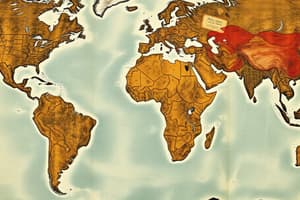Podcast
Questions and Answers
Which event marked the beginning of the break-up of Pangaea?
Which event marked the beginning of the break-up of Pangaea?
- Collision of Laurasia and Baltica
- Pangaea existed until around 200 Ma (correct)
- The separation of India from Gondwana
- The formation of the Himalayas
What was the primary result of the collision between India and Eurasia?
What was the primary result of the collision between India and Eurasia?
- Separation of Gondwanaland and Laurasia
- Closure of the Iapetus Sea
- Creation of the Atlantic Ocean
- Formation of the Himalayas (correct)
During which geological period did the continents reach their current positions?
During which geological period did the continents reach their current positions?
- Tertiary Period
- Late Carboniferous
- Quaternary Period (correct)
- Triassic Period
Which supercontinent existed around the South Pole during the late Cambrian period?
Which supercontinent existed around the South Pole during the late Cambrian period?
What significant geological process occurred from the late Carboniferous to the Triassic period?
What significant geological process occurred from the late Carboniferous to the Triassic period?
What phenomenon caused the opening of the Atlantic Ocean?
What phenomenon caused the opening of the Atlantic Ocean?
What key event took place during the mid-Ordovician Period?
What key event took place during the mid-Ordovician Period?
Which statement is true regarding the formation of the North American continent?
Which statement is true regarding the formation of the North American continent?
Flashcards are hidden until you start studying
Study Notes
Formation of Continents
- The Gondwana Supercontinent, including Baltica, Siberia, and Laurasia, existed around the South Pole during the late Cambrian period (514 Ma).
- During the mid-Ordovician Period (458 Ma), Laurasia collided with Baltica, closing the Iapetus Sea.
- These collisions resulted in the pre-Pangaea continent during the early Devonian period (390 Ma).
- The North American continent formed by the late Carboniferous (306 Ma).
- By the Triassic Period (255-210 Ma), Pangaea existed.
- Pangaea began to break apart from 210-180 Ma.
- The breakup of Pangaea continued into the Late Cretaceous period, creating larger oceans.
- Continental drift proceeded into the Tertiary Period.
- Continents reached their current positions during the Quaternary period.
Pangaea's Break-Up
- The present-day continents were part of the supercontinent Pangaea, existing until approximately 200 Ma.
- Around 160 Ma, Pangaea split into two large landmasses: Gondwanaland and Laurasia.
- The subcontinent of India moved northward and separated from Gondwana around 140 Ma.
- India collided with Eurasia, initiating the formation of the Himalayan mountain range.
- Australia separated from Antarctica around 100 Ma, further breaking Gondwana apart.
- The separation of Gondwana and Laurasia led to the opening of the Atlantic Ocean.
Studying That Suits You
Use AI to generate personalized quizzes and flashcards to suit your learning preferences.




